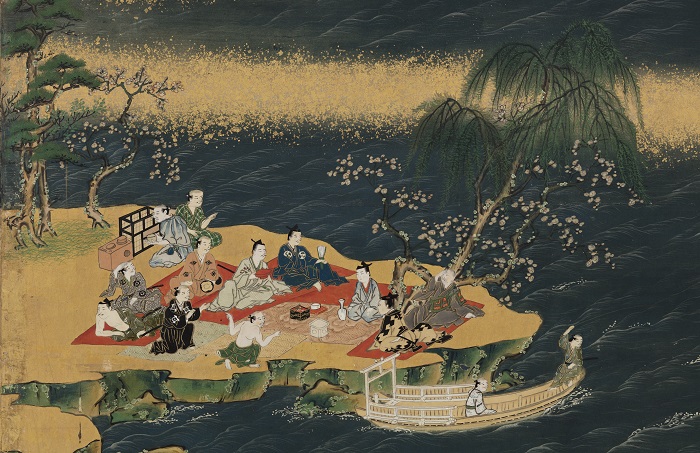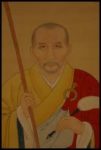
Attributed to Tosa Mitsuoki
Japanese, 1617-1691
The Tale of Bunshō, the Salt-maker, 1688
ink, color, gold, and silver on paper; set of three handscrolls
12 7/8 x 560 5/8 in.
SBMA, Museum purchase with the Peggy and John Maximus Fund and SBMA Friends of Asian Art
2012.7.1-.3

Tosa Mitsuoki - Self-portrait, 1679
"Do not fill up the whole picture with lines; also apply colors with a light touch. Some perfection in design is desirable. You should not fill in more than one third of the background. Just as you would if you were writing poetry, take care to hold something back. The viewer, too, must bring something into it. If one includes some empty space along with an image, then the mind will fill it in." - Tosa Mitsuoki
COMMENTS
“Monogatari: Tales of Japan” Exhibition At Scholten Japanese Art
In conjunction with Asia Week New York 2011, the gallery presents “Monogatari: Tales of Japan,” which will offer paintings, woodblock prints and a selection of netsuke devoted to the art of story-telling.
One of the highlights of the exhibition will be an illustrated manuscript recounting “The Tale of Bunsho (Bunsho Zoshi),” in the format of three hand scrolls with text by the court calligrapher Mushanokoji Sanekage (1661-1738) and illustrations attributed to Tosa Mitsuoki (1617-1691), one of the most important Tosa school painters of the Edo Period (1603-1838).
“The Tale of Bunsho (the Saltmaker),” is one of a group of short stories called otogizoshi, compiled in the Muromachi period (1338-1573) but more widely known by the 17th and 18th centuries. Sets of hand scrolls, such as this, were often commissioned from Kyoto artists for New Year’s or dowry gifts. This particular tale recounts the life of Bunda (who later changes his name to Bunsho), a lowly servant, who through hard work and devotion to a particular shrine is able to achieve fortune and happiness for his family. The set, formerly in the collection of the Viscount Todo Takanori (1894-1947), was previously exhibited in the illustrious Japan-British Exhibition at the White City in London in 1910.
https://artefuse.com/2011/03/18/monogatari-tales-of-japan-exhibition-at-scholten-japanese-art/
SBMA CURATORIAL LABELS
This set of handscrolls, lavishly decorated with gold and pigments, is from the former collection of Viscount Tōdō Takanori (1894–1947). It was likely acquired around 1688, when dated and signed by high-ranking court calligrapher Mushanokōji
Sanekage whose elegant calligraphy graced the handscroll. Tosa Mitsuoki, reviver of the classical style, established the Tosa school as the official painters of the imperial court in Kyoto.
Tale of Bunshō is one of the ultimate rags-to-riches stories of pre-modern Japan. The story arose out of myths and legends in the 15th century and was circulated in scrolls, like this set, as well as in hand-painted and printed books throughout the 18th century. The story recounts how Bunshō, an attendant at a Shinto Shrine, left his service to become a wealthy salt merchant. Through hard work, good deeds, and devotion to the deity Kashima, his beautiful daughters brought him more wealth and social status as one married an imperial prince and the other the Emperor.
The story resonated with the merchant culture of the early-Edo period and became popular among urban elites. With its auspicious themes of good fortune and moral lessons, it soon became a favorite New Year’s Day “first reading,” especially for girls.
- Asian Art Reopening, 2021
"The Salt Maker", written in the Muromachi period (1392–1573), was originally a story for general readers. In the Edo period (1615–1868), the story was modified to include insights about history and legend in order to make it more appealing for an elite audience. The story recounts how Bunshō, an attendant at Kashima Shrine, left his service to become a wealthy purveyor of salt. Through hard work, good deeds, and devotion to the deity Kashima, Bunshō was able to achieve good fortune and happiness for his family. His beautiful daughters brought him even more wealth and social status as one married the Emperor and the other an imperial prince, son of the Regent.
In this illustrated handscroll, the alternation of calligraphy and image, the styles of figures with simplified facial features, the brilliantly delineated costumes and the “roofless” architecture seen from above, as well as the lavishly applied mineral pigments and gold, draw upon the narrative handscroll tradition from the golden age of the imperial court in the 10th – 12th centuries. Tosa Mitsuoki revived and updated this style in the 17th century and established the Tosa school as the official painters of the court.
This story resonated with the emerging merchant culture of the early Edo period and became popular among the urban elite. With its auspicious themes of good fortune and moral lessons, it soon became a favorite New Year's Day "first reading," especially for girls.
- Paths of Gold, 2018
